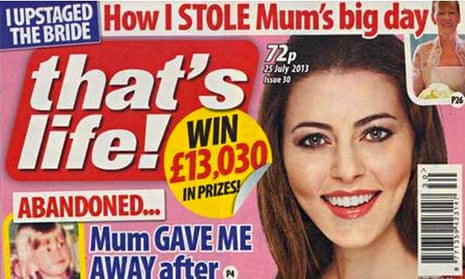A magazine devoted to publishing “real life stories” has been censured by the Independent Press Standards Organisation (Ipso) for running a story that turned out to be anything but real.
In October 2014, That’s Life carried an article under the byline of Leanne Owens headlined “I’d rather die than kill my baby.”
Purporting to be a first-person account of the serious illnesses Owens had experienced while pregnant with her fourth child, it reported that she had risked her own life to give birth to a baby girl.
By extension, it also suggested she had risked leaving her other children without a mother.
But the magazine had got the wrong end of the stick. Owens had not risked her life by continuing with her pregnancy. Instead, she had been told that, with treatment and monitoring, she would survive. It was her unborn baby who might not survive.
Owens told Ipso she had been phoned by a journalist working for the magazine who had read the proposed article to her for approval. However, she had repeatedly told the journalist that she was in a doctor’s surgery and could not hear her clearly.
Owens said she had promised to call the journalist back at a more convenient time but on three occasions she had been told that the writer was unavailable and left a message. She never received a return call.
For its part, the magazine said it believed that its article was an accurate account of the complainant’s difficulties during her pregnancy. The journalist who read the copy to Owens by phone did not recall her saying that she was unable to hear properly. So the magazine believed that the copy had been approved.
The magazine said that Owens had originally sold her story to a news agency, and the published copy was true to the copy provided by the agency, which had also been approved by the complainant in a read-back process.
However, there was no taped record of either of the read-back conversations.
Although the magazine maintained that there had been no failure to take care over the accuracy of the article, it offered to publish a correction on the letters page, its standard placement for corrections. It read:
“Last year we told the story of Leanne Owens whose unborn baby girl Seren helped to identify her breast cancer while she was pregnant. Leanne has asked us to make clear that when she was originally offered the chance to terminate the pregnancy, due to antiphospholipid syndrome, the doctors did not tell her that her life was at risk.
In fact, it was her unborn baby whose life was at risk. As such Leanne never felt that she risked leaving her sons without a mother when she decided to go ahead with the pregnancy. We are happy to make this clear and apologise for any distress caused by this misunderstanding.”
Ipso’s complaints committee ruled that the magazine had not taken appropriate care with the article, regarding it as a “significant” inaccuracy. It therefore upheld Owens’s complaint that the magazine had breached the clause on accuracy in the editors’ code of practice.
It decided that the magazine’s correction and apology - which Owens did not regard as sincere - should be placed more prominently in the next issue of That’s Life because the inaccurate story had previously been referred to on the front cover.
So, said Ipso’s committee, “in order to remedy the breach... the magazine is now required to publish its proposed wording, in full, on the first editorial page.”
Source: Ipso
NB: In April 2013, That’s Life was censured by Ipso’s predecessor, the Press Complaints Commission, for breaching the code by paying the sister of a murderer for her story, ruling that she had directly benefited from her brother’s crime.

Comments (…)
Sign in or create your Guardian account to join the discussion